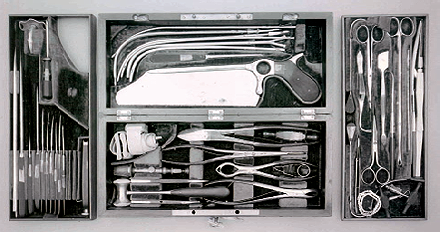![]() In an aerie that's home to the Medical college archives, a royal charter and some vintage bedpans
In an aerie that's home to the Medical college archives, a royal charter and some vintage bedpans
In an aerie that's home to the Medical college archives, a royal charter and some vintage bedpans
On the Ithaca campus, the archives reside in a sub-basement—deep underground in Kroch Library's Rare and Manuscript Collections. At the Medical college in New York City, it's the opposite: its repository of institutional memory is located far above the East River's waters.
To get there, you take a vertical ride to the twenty-fifth floor of Baker Tower. It's not a quick trip; only one elevator serves the archives, and its operator must be coaxed to pick you up between patient transports. Once arrived, you have a literal bird's-eye view: outside the window is a nested pair of peregrine falcons. They're a protected species, and whenever Weill Cornell does exterior maintenance, it has to work around them.
Housing the records not only of the Medical college but of NewYork-Presbyterian Hospital/Weill Cornell Medical Center and its progenitor institutions, the archives include some 6,000 linear feet of documents and more than 15,000 photographs. Then there's all the assorted ephemera: Civil War-era surgical instruments, old microscopes, various awards, the hulks of discarded medical equipment. "We don't encourage it, but we get what people send," longtime head archivist Jim Gehrlich laments, touring the archives a few weeks before his retirement in June. "We've become the attic of an old house. If people don't know what to do with something, they say, 'Send it up to the archives.'"

In one corner is a stack of brass letters, dismantled when the medical center's Greenberg Pavilion was built in 1993, that spell out the name of the Lying-In Hospital. "People didn't want to throw them away," Gehrlich explains. And what's that round thing? "It's an old wheel that was found on the site of the brewery that was here before this building was built." Across the way is what looks like a clear plastic dollhouse, furnished with Seventies-era décor; it proves to be a bygone collection box for donations to buy gifts for needy pediatric patients. "It has no archival value, but they were cleaning a room downstairs and sent it up here," Gehrlich says with a now-familiar sigh. "It used to be in the room where employees cashed their checks, which nobody does anymore, and if they got any coins they would put them into the 'penny fund.' There's still some change in it."
Though such objects—like, say, the stack of vintage bed-pans—may catch the visitor's eye, for Gehrlich they were more of a space-hogging headache. Yes, some have curatorial value, such as the glass slides that anatomy professor George Papanicolaou used in creating the Pap smear. But the archives' real mission is to preserve photographs and documents—the most precious of which is the royal charter, dated June 13, 1771, and written on three map-sized sheets of sheepskin, that King George III granted to what would become New York Hospital. It resides in a custom-made box, which Gehrlich kept in his coat closet. "This document is older than the Declaration of Independence," he says. "The U.S. government has spent millions on preserving that, and we've spent maybe $500 on this. It's hardly readable anymore. Part of the reason is that for almost a hundred years, it hung over the fireplace in the Board of Governors room."
{youtube}oOelPlxK5W4{/youtube}
About Dr. Papinicolau (14:00)


